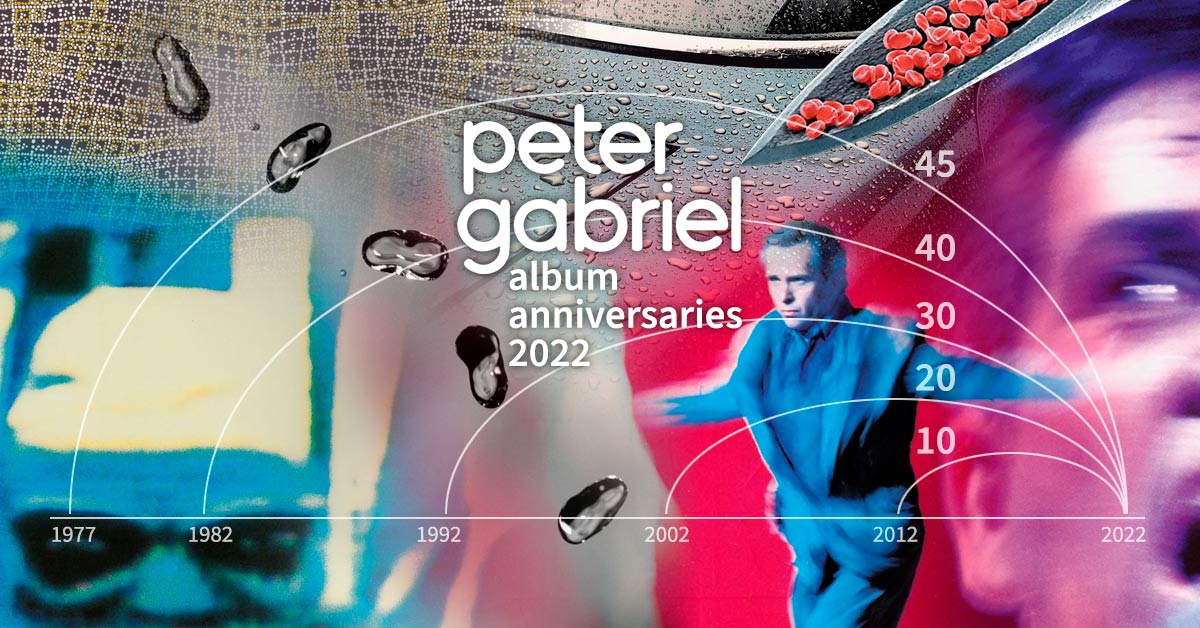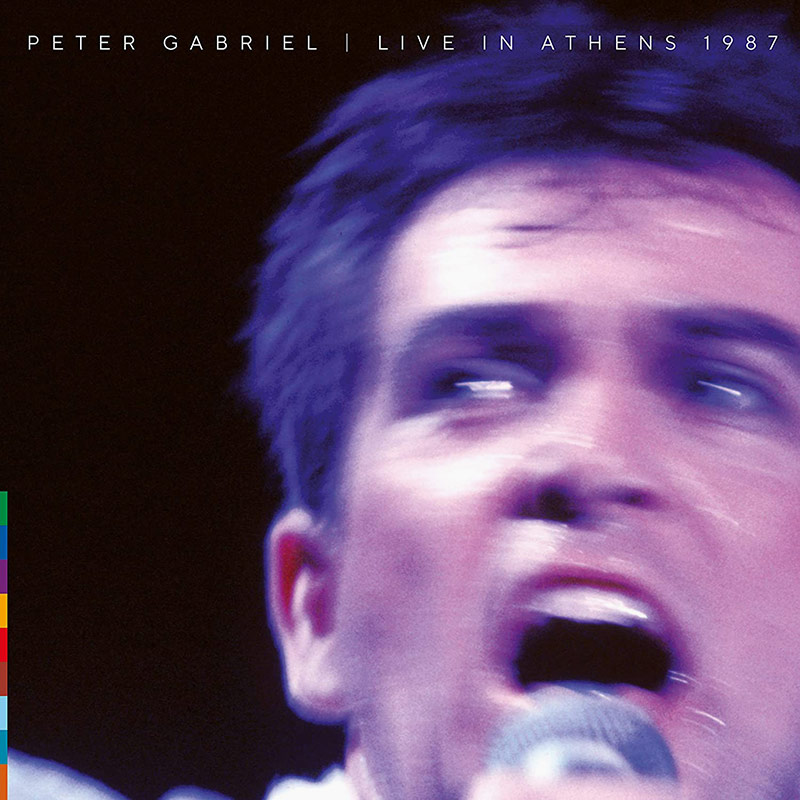- Article
- Read in 22 minutes
Peter Gabriel – Anniversary year 2022 (albums)
The years that end with a two are, in Peter Gabriel’s case, special years. Because in them, an astonishing number of his solo albums have a round anniversary. We would like to comemorate the anniversary with a small series of articles.
The years that end with a two are – in Peter Gabriel’s case – special years. Because in them, an astonishing number of his solo albums always celebrate major anniversaries. On the last few occasions, this fact was unfortunately never duly acknowledged by us – in fact, mainly because another new release was just around the corner.
This time it will be different and the special anniversary year will be celebrated with a small series of articles. Here, we will look back at the time of the release, the state of Gabriel’s life and career and what kind of response the album triggered among fans and the music world. We will always add a new anniversary to this article on the respective release dates and then also post a suitable thread in the forum where you can have your say.
We are aware that the albums in question are not connected by anything except this coincidence of numbers. But we take this as an opportunity to commemorate the works – and since they contain many central markers in Gabriel’s oeuvre, this will certainly be interesting.
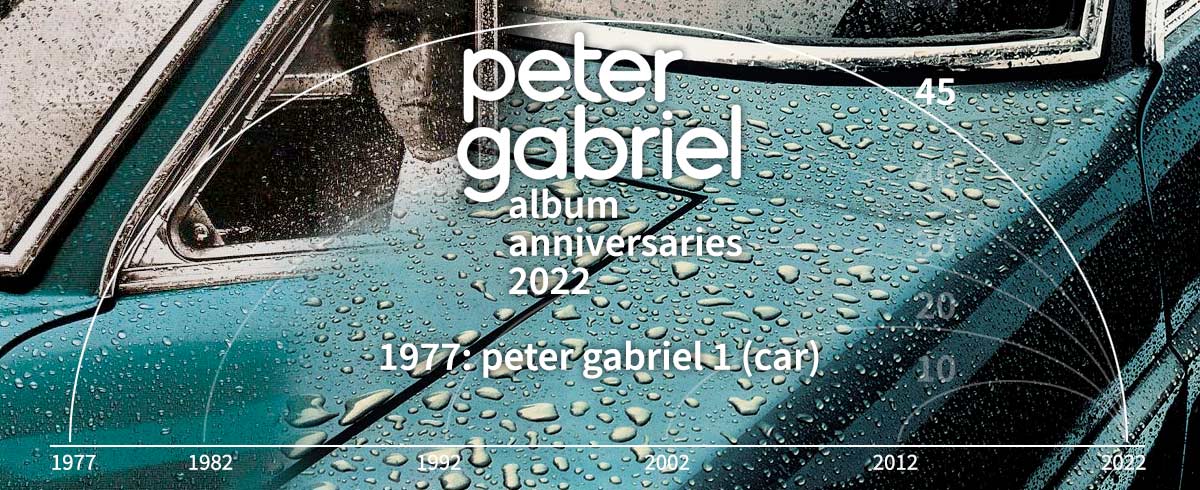
peter gabriel (I / Car)
Right at the beginning of our series comes the exception to the rule – because the year Gabriel’s first solo album came out didn’t have a two at the end, but a seven. It was released on 25 February 1977 – and is thus 45 years old this year. so it is a “half-round” birthday, but one that we also want to honour.
1977 – this was the year in which the radical activity of the RAF increased in Germany until it finally led to what is commonly called the “German Autumn”. In South Africa, the terror of apartheid raged, leading to the death of Steven Biko later in the year, Pink Floyd released their Animals album, the first Star Wars film was released and the German Federal Railway took the last steam locomotive out of service.
Into this Gabriel sent his first album, which is generally regarded as a still uncertain attempt. In any case, it unites the most diverse musical styles – hard rock, introverted alternative experiments, orchestral bombast, and much more. Gabriel himself said that he tried out so many things to find a way for himself alone – without Genesis – in the first place.
To do this, he had also travelled out of England, out of all of Europe: Most of it was recorded in Toronto. Bob Ezrin was the producer – just for this one time. Gabriel eventually asked him again much later, when he needed support for his Scratch My Back project in 2009. But a few other participants became important in Gabriel’s work for years to come: First and foremost Tony Levin, who was and is his main bassist since this debut. Then also Larry Fast, who remained on the keyboards at least for the next few years, especially at concerts. He can certainly be considered something like Gabriel’s teacher in terms of synthesiser technique and sound design. Finally, Robert Fripp on guitars, an important musical personality; he was to produce the entire next album. Drummer Jerry Marotta, on the other hand, was not yet there.
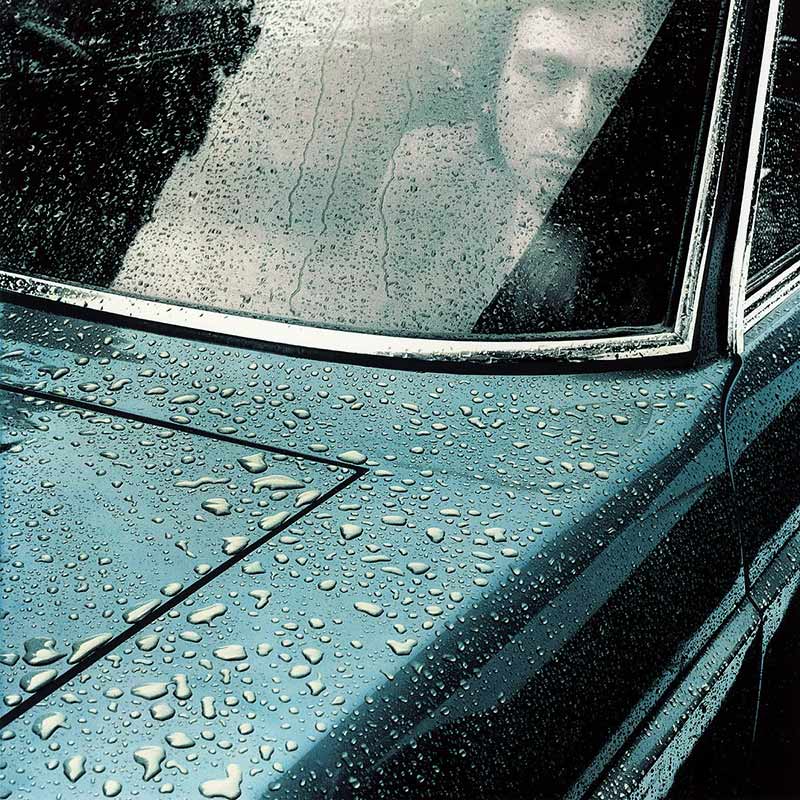
Then finally the album appeared. The experts were quite enthusiastic. For example, Rolling Stone: “He writes great melodies; he can still be quirky when he wants; he likes dramatic orchestration and studio technique. […] Gabriel’s more symphonic pieces, some with five or more movements, are so complex they can take your breath away. […] This is an impressively rich debut album. And I still don’t know what to expect from him next.”
Among fans, the first album is still one of the most popular of his solo albums. Possibly especially among older fans who still knew the early Genesis years and experienced the first solo output of their idol as something special.
Of course, the most outstanding song is Solsbury Hill, which became a hit single, is still played on the radio and is an essential part of any Gabriel concert. It is probably the song that Gabriel has sung live by far the most often. Perhaps closely followed by Here Comes The Flood, which has also appeared with great repetition in his set lists since then – albeit in the musically completely reduced version. In addition, Moribund The Burgermeister or Humdrum have also enjoyed long-lasting affection from fans.
Down The Dolce Vita or Slowburn, for example, have turned out to be rather less ageing – basically almost completely what was called a second album side in the days when music was still distributed on LPs. Too big the musical gesture, too little the penetration of depth.
The most unusual piece, which therefore sticks in the memory, is probably Excuse Me. Maybe it stands for this whole album full of friction with its weirdness.
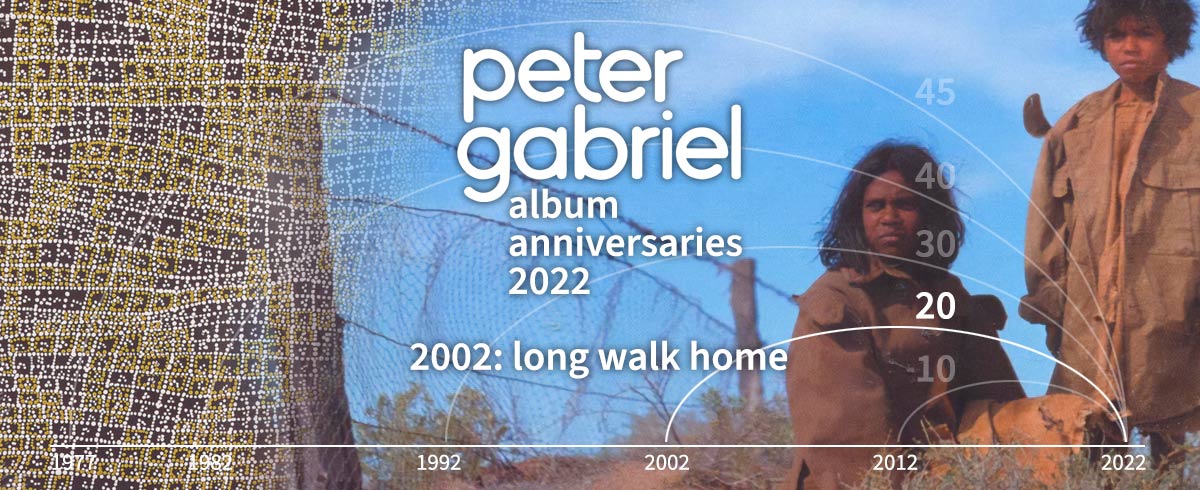
Long Walk Home
Music from the “Rabbit-Proof Fence”
The second album in the anniversary series (we go by the month of release and not by the chronology of years) was released on 25 March 2002 (at least in Australia – in the rest of the world a few weeks or months later).
At the beginning of this year, the euro had just been introduced as a real currency with coins and notes. Since then, it has also been used to pay in shops. In January, the USA set up a detention centre in Guantanamo, Cuba, to hold “non-combatant enemies”. In addition, both Klitschkos still boxed (also won) and Astrid Lindgren died at the age of 95.
During this time, fans were eagerly awaiting Gabriel’s new studio album (yes, some things always come back in life?), which was finally promised for later in the year. But before that, Peter Gabriel surprised everyone with the release of his third film soundtrack. Nobody had expected that. This time it was for Rabbit-Proof Fence by Phillip Noyce. The album was released under a different name, namely the one the film also had in Germany and other countries: Long Walk Home.
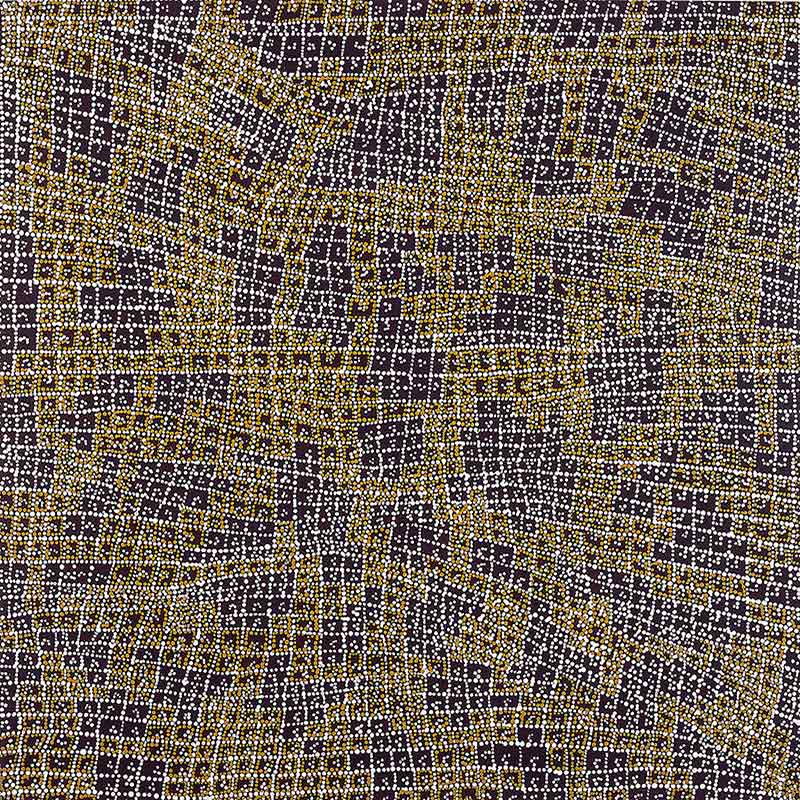
Gabriel had made a name for himself with the two scores for Birdy and The Last Temptation Of Christ as a film composer who achieves deep impact and does so with his very own means. According to his own statements, he was interested this time in the fact that Noyce’s film offered a lot of open space for atmospheric music with little dialogue. So he agreed to produce it, but was then very busy with his own album, which was in the final stages of production. This was the second time this happened to him (although Birdy and Sky Blue, however, is present in two barely disguised versions.
Besides Rhodes and Evans, who were not only producers but also musicians, there were others who worked with Gabriel during the OVO and UP periods. Ged Lynch, The Dhol Foundation, Shankar, Hossam Ramzy, Alex Swift, Nusrat Fateh Ali Khan, The Blind Boys of Alabama should be mentioned here. But there is also a whole range of Australian musicians from the Aboriginal culture, which follows logically from the content of the film. In addition, a variety of natural sounds are used. Bird calls, for example, which have been alienated so that they can hardly be made out.
Billboard stated the soundtrack deserves “special attention for its musical merits”. The album was further described as “atmospheric, often menacing” and as “a cumulative emotional force” due to its “interwoven motifs”.
At the same time, the structures of the album are quite demanding with the constant breaks, pauses and new beginnings. Also demanding are the musical elements, which bring to mind terms like “rumbling” and “droning”. They are Gabriel-typical warm, but nevertheless not always soothing experimental sounds – which also usually have less emotional power than on Birdy or Passion. The tracks that have the most impact are those that hark back to songs by OVO and UP: Running Through The Rain, On The Map or Jigalong. Not to mention the anthemic Cloudless, which functions as a kind of title theme.
Fans mostly found the soundtrack a bit brittle and the album doesn’t rank among the very most popular. Or, to be more explicit: it ranks at the very back. The film also remained rather unremarkable. While not a total failure, Long Walk Home is a strange marker in Gabriel’s career.
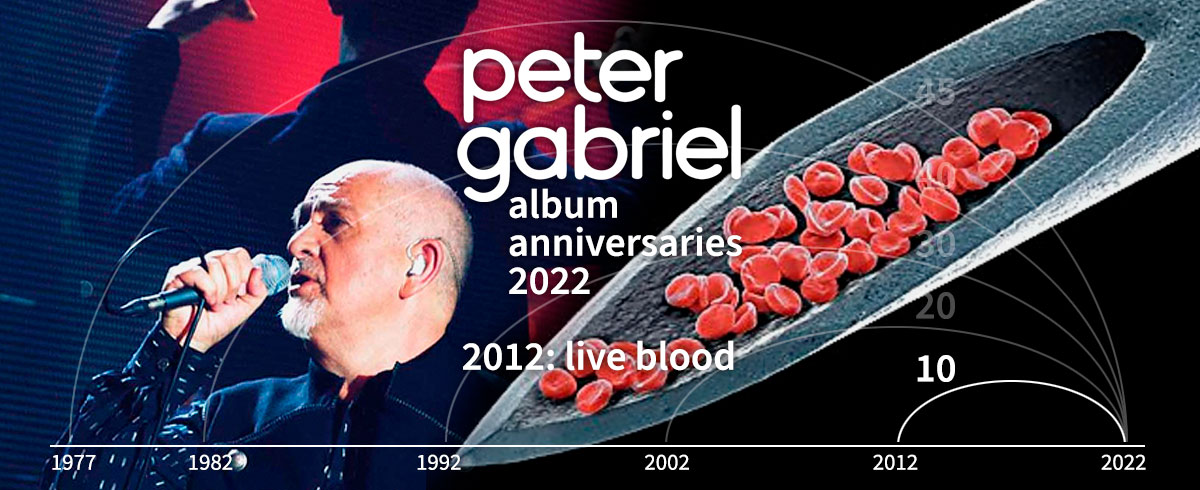
Live Blood
The third album in the anniversary year is Live Blood from Gabriel’s orchestral project. It was released on 20 April 2012 (in Germany – in the rest of the world on 23 April). It’s certainly not the most memorable work in Peter Gabriel’s discography, but it still belongs here. (The big bangers will come later in the year – in September, of course…)
The year 2012 was still marked by the Arab Spring, German President Christian Wulff resigned and Joachim Gauck was elected, Microsoft released Windows 8, the Italian passenger ship Costa Concordia ran aground and Die Toten Hosen celebrated 30 years on stage.
Gabriel, on the other hand, had been busy with his orchestral project (which had actually started as a cover project) in this and the years before and had grown from a small side affair into something quite big. Just like the tour for it, which had expanded from the original three dates to a concert tour over three years.
The two evenings on which the album was recorded in March 2011 were the beginning of a new leg of the tour, in which the previous evening’s schedule was changed. The focus was no longer on the cover album Scratch My Back, but on Gabriel’s own pieces in orchestration. At the beginning of this part of the tour, the new set list had not yet been tested, had weaknesses and was improved as the tour progressed. The musicians involved also seemed a bit out of routine after half a year of concert break. Therefore, it was certainly not the smartest idea to choose these concerts for a recording. Mind you, for a film recording. Because these concerts were primarily recorded with cameras.
This then also represents the second flaw of the album, because it is simply the transfer of the film soundtrack onto CD. Including intro and end credits music. What Realword, in conjunction with Eagle Records, had put on the market seemed a bit loveless.
After all, the musicians are the tried and tested Scratch My Back team: Ben Foster as conductor of the orchestra, Louisa Fuller as concertmaster, Tom Cawley on the grand piano and Melanie Gabriel and Ane Brun on backing vocals. In addition, at the end of In Your Eyes, Sevara Nazarkhan makes an unusual (and also unique on the tour) guest appearance.
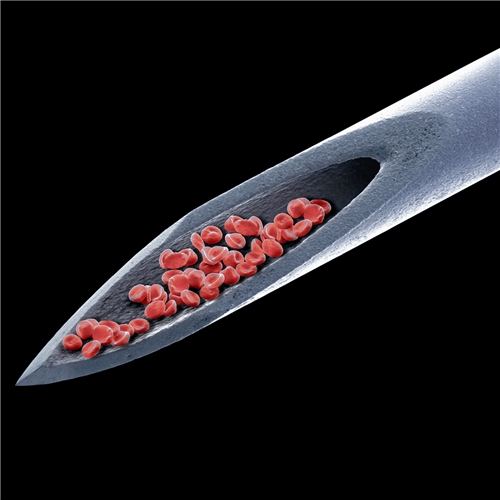
Reviews of the release were favourable at best. The Independent gave it three stars out of five, saying that after Scratch My Back and New Blood, “Peter Gabriel may return to this well once too often with another two-hour live set on two CDs of what continues to be the same material. […] The overall effect can be demoralising.”
There was no great response to the music among the fans. Neither did the recordings generate great enthusiasm nor great rejection. However, the film had already been released the year before. The deluxe edition included a bonus CD with a shortened recording of the concert, which was advertised as a special extra. Of course, this became invalid with the release of the complete recordings and annoyed many buyers. Here, too, Live Blood wasn’t a fan release.
The album’s tracklist consists mainly of Gabriel pieces in orchestration, known from the album New Blood, and four songs from Scratch My Back. The arrangements hardly offer anything new. At least: The Drophad not been available before, Downside Up was now available in the long version, as well as Solsbury Hill with the “Freude schöner Götterfunken” passage. Sevara’s performance during In Your Eyes is charming but unspectacular (it had already been on Growing Up Live).
So, on the whole, it has to be said that Live Blood unfortunately had weaknesses. From the shaky performance of the singers and PG himself to the suboptimal setlist and the questionable release policy.
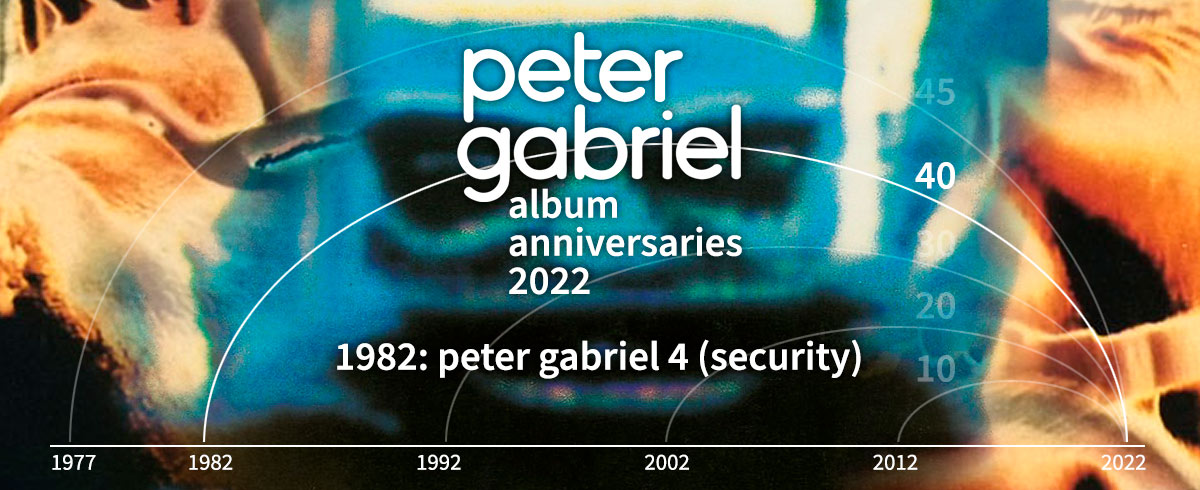
peter gabriel (IV / Security, + deutsches Album)
Meanwhile, it has finally become September. This month has seen the release of several of Gabriel’s albums over the years. On September 10, 1982, for example, the fourth solo album (aka “Security”), making it 40 years old today. It represented, after the third album (also called “Melt”) released just two years earlier, another important marker of his path. It was the beginning of the time when Gabriel made the most impression with his music and reached the highest output in terms of quantity.
The year 1982 had not been poor in events so far: The Falklands War had begun, in Germany there was the largest rally to date with around 350,000 people (against nuclear missiles and the arms policy symbolized by Reagan), later in October of that year Helmut Kohl was to become Chancellor after a constructive vote of no confidence and he would remain for 16 years. Film classics like E.T., Blade Runner or Fitzcarraldowere shown in the cinema. Not to forget Pink Floyd: The Wall by Alan Parker. In the charts stull like Do You Really Want to Hurt Me, Come On Eileen or Mad World appeared. The early eighties were a changeable time in the friction between awakening and stolidity.
Gabriel walked on new paths. On the fourth album perhaps as strong as never before and hardly after again. He had finally discovered sampling and now made even greater use than on the previous album. He went in search of sounds (the names of the resulting files he listed meticulously in the album credits) and with the results he then built pieces in which atmosphere and sound often prevailed over reverberating melodies. He moved away from the usual rock music structures.
Another new current was the beginning of Gabriel’s passion for world music. Really noticeable here only in the African drums at the end of The Rhythm Of The Heat, but in July 1982 the first WOMAD festival had already taken place. A musical direction that was to gain considerable importance for Gabriel in the future.
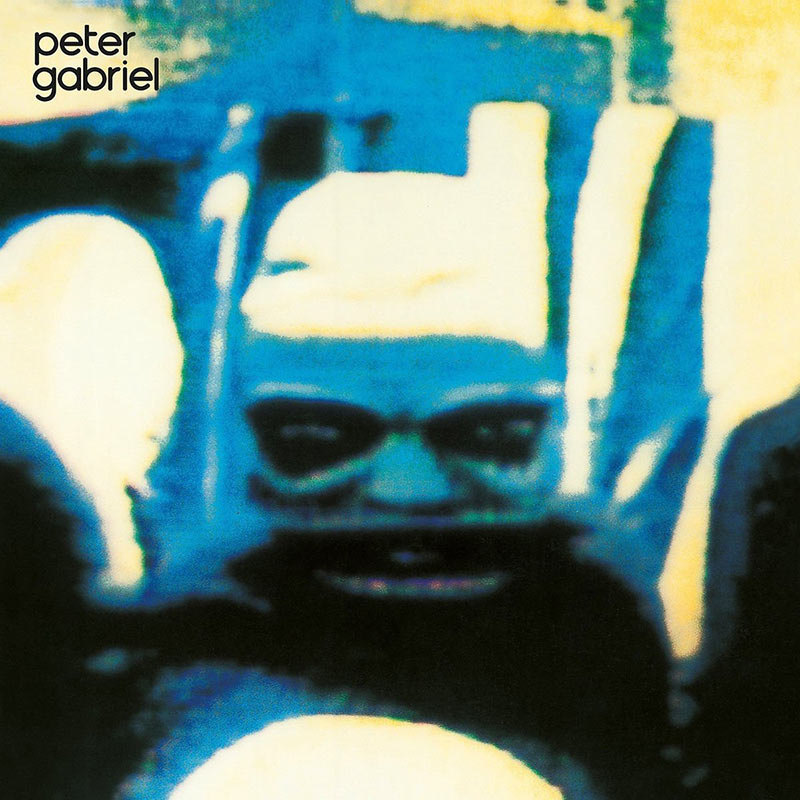
Surprisingly, the personnel lineup of the album is quite compact. Essentially, the regular band (Larry Fast, Tony Levin, Jerry Marotta and, more recently, David Rhodes), which is emerging as an increasingly solid entity, is effective. Significant guest musicians are John Ellis on guitar, Peter Hammill in the background choir and Jill Gabriel, who sings on San Jacinto. With David Lord, Gabriel had gotten himself the fourth producer. Both seemed to have the best connection to each other so far and maybe there would have been fruitful further cooperation, but Lord started an affair with Gabriel’s wife Jill and that was the end. In the next few years, the coming separation from Jill should still dig strong furrows in Peter and various consequences are also reflected in his music.
But here, first of all, was an album full of novelties and unfamiliarities, yet accessible and engaging. It is much softer and warmer than its predecessor – though not necessarily more peaceful at every point. What it has in common with its predecessor is that the lyrics again tell of very strong individual states and form an inseparable bond with the music.
For this album Horst Königstein again made a translation into German. This time he was involved early and already influenced the English lyrics. He later admitted himself that he didn’t have such a sense for the emotional, more for the thought. So German lyrics were created, which this time were in parts even less musical than at the first beginning.
After all, the reviews of the album itself were rather restrained. The Record Mirror’s summary read, “Gabriel walks a fine line between brilliance and total crap.” There was chafing at the melancholy and off-kilter nature of the compositions. After all, the New Mesical Express wrote, “Even if the album is flawed and difficult, it also shows itself to be exceptionally spunky and experimental. Ugly and expansive as it often seems.” Apparently one had come along with the brittle roughness of the third album even better, which followed even more clearly usual song structures.
The fans, however, loved the album and it is still one of the most popular today. This certainly has to do with the fact that in a sense it represents the culmination and conclusion of Gabriel’s first solo creative period.
Almost all of the eight pieces have made it to high sustainability. Songs like San Jacinto and The Rhythm Of The Heat are still played at Gabriel’s concerts. Other pieces are heard more rarely, but have an almost legendary position in the oevre (Wallflower, Lay Your Hands On Me, perhaps I Have The Touch). With Shock The Monkey there is also a hit single, which is not necessarily pleasing, but resounding, and was awarded an enormously strong video. Only the unwieldy The Familiy And The Fishing Net can’t establish itself permanently, even if its depth is appreciated on all sides – and the fast-paced but somewhat unspecial Kiss Of Life is even almost completely lost.
Finally, it should be noted that this is the only solo album so far that doesn’t feature Gabriel’s face on the cover.
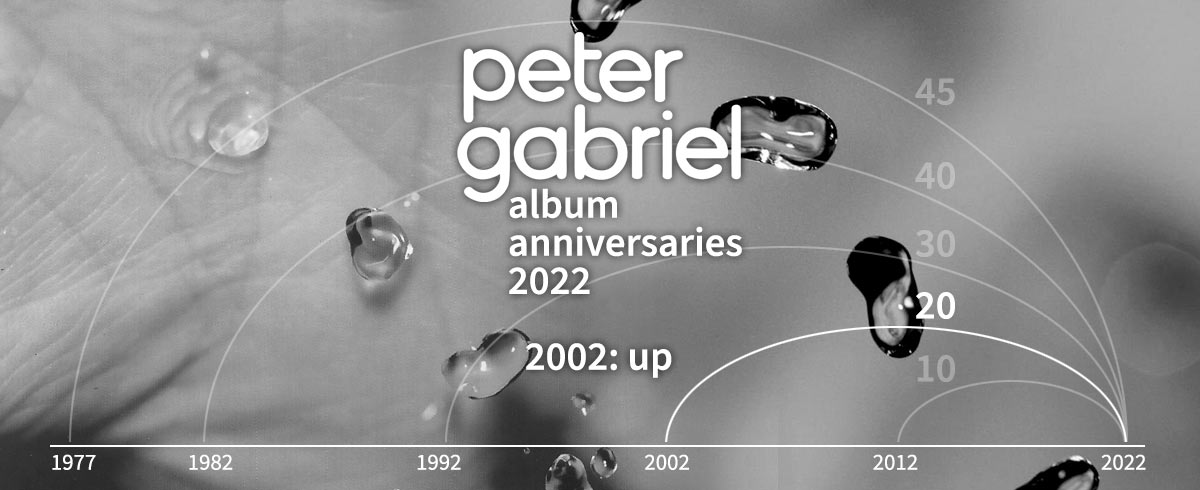
UP
An album called UP had been announced for a long time, but it was a long time coming. There were repeated delays, in the end even the old name was in question (but was confirmed by a vote among the fans) – and finally on 23 September 2002 the time had come and the album was released – exactly 20 years ago.
After the predecessor X-Plora 1 and EVE, a few individual pieces appeared, rumours of “recording weeks” in the Realworld studios were heard – but nothing fundamentally new happened. No tour, no music on the scale of an entire album. For eight years.
In 2000, the strangely musical-like OVO was released, and in spring 2002, the soundtrack Long Walk Home came as a relative surprise. What was missing was a proper solo album. Gabriel had also gone from being a somewhat offbeat independent rocker of the 80s to a pop superstar who was honoured wherever he went. A nimbus that is not easy to live up to.
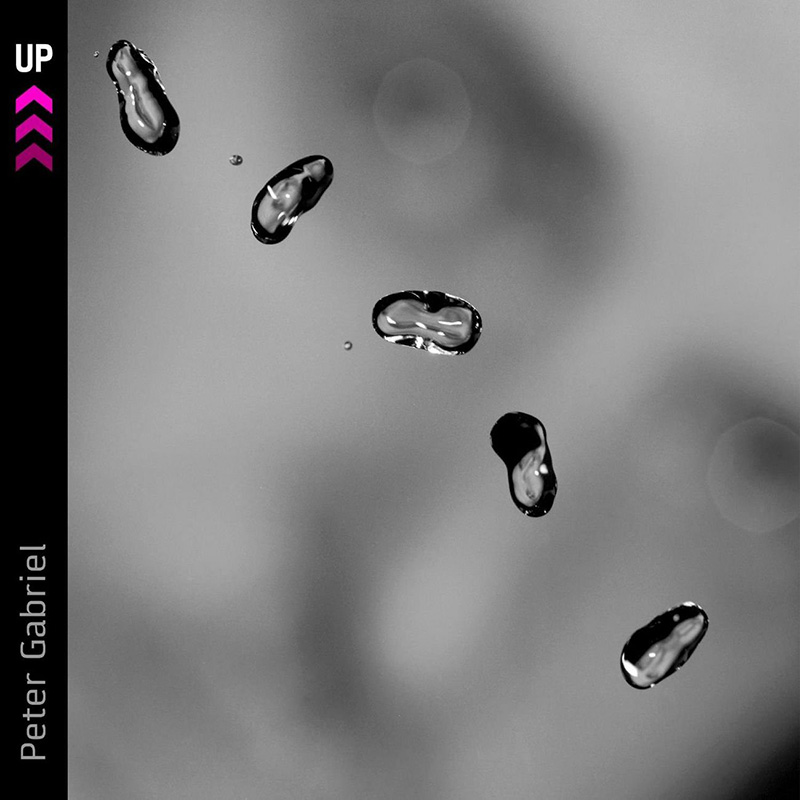
Perhaps it is fair to say that the world had to deal with a lot of confusion and doubt in 2002. For a good year, the aftermath of 9/11 had been taking effect and the war in Afghanistan was in full swing. In April, there was a rampage at a school in Erfurt in Germany and shortly before the album was released, the Red-Green government led by Chancellor Schröder had only just been re-elected in September. The EURO bacame the new currency in several EU-counries. In the charts, there were opposites like the cuddly Just More by Wonderwall or the Ketchup Song – and Eminem was at the peak of his career.
And UP was about death. It is the subject of at least five of the ten songs. For the album, Gabriel had done a lot of scurrying around. He made recordings that he worked on again and again. To do this, he occasionally travelled to different corners of the world. In between, he was distracted by his many political projects and his young, new family. Also strokes of fate such as the death of close friends and family members. The works were never focused.
UP is no longer a world music album. Rather, electro references dominate. A manipulation of the sounds used prevails until the origin is unrecognisable. The result is soundscapes that do not seem earthy, not electronic, but something in between. Sonically, everything seems possible in this universe. The piano, which repeatedly moves to the centre, seems almost unexpectedly unambiguous.
Similar to US, the list of musicians involved is enormously long – unlike there, however, it is much broader in orientation. Levin and Rhodes are still part of the core team, but there are five different drummers. Plus nine people on percussion plus the Dhol Foundation. Daniel Lanois and Peter Green are sometimes heard on guitar, or older recordings by Nusrat Fateh Ali Khan. Again and again, winds and strings are mixed in, with Bob Ezrin sometimes working on the arrangement: Everything is synthesis – Peter makes ample use of the skills of others.
On the other hand, he has no consistent producer. Tchad Blake works on I Grieve, Steve Osborn on Growing Up. Overall, however, there is no tightening hand. Therefore, even more musical layers are audible on the album than on US, even more ideas have flowed in – with less sorting out.
UP is generally perceived as similar to Gabriel’s fourth solo album, but less captivating. Commercially, it is only moderately successful. Rolling Stone writes “Gabriel, long one of rock music’s most innovative artists, has never sounded more detached.” And AllMusic says: “This is not an accessible record, nor is it easy to get comfortable with, which means many will dismiss it after one or two listens.” At least from Mojo comes: “A sometimes disturbing, but often breathtakingly beautiful record.”
A really successful song also needs lyrics that are in harmony with the music, that open something up and make you move inside. This seems to be a little difficult with UP. The Barry Williams Showhas a theme that is already past its sell-by date when it is released. It’s a pity, because the funk-driven piece actually had the potential to be a high-flyer. Gabriel himself no longer played this song live just one year later and it is not represented on the best-of collection HIT. Instead, More Than This and Growing Up are included – somewhat optimistically – as if they were great evergreens. They aren’t. Again the lyrics: The repeated statement, also delivered somewhat defiantly, that there must be “more than this” is not enough to open up an inner universe. And wanting to tell the life cycle from birth to death is quite a lot for a song. In the last twenty years, Darkness has proved to be the most enduring (it seems personal and honest), as well as Signal To Noise (which almost counteracts the lyrics with its bombastic music).
What else could be said: In the style of the art project on US, this time a black and white photograph is assigned to each track. Diverse in effect again, but more austere, less luminous.
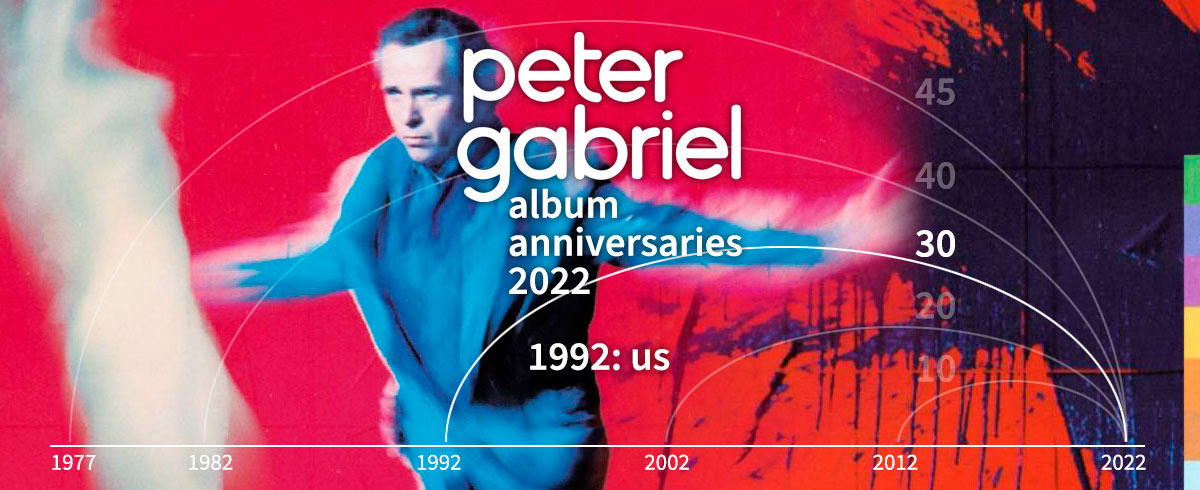
US
Has it ever been mentioned that Gabriel always takes quite a long time to finish an album? After his mega-success So, he needed six years for a follow-up. By today’s standards, that’s actually quick, but back then, both the fans waited eagerly (at least Passion was released in between) and his record company must have drummed their fingers impatiently. At that time you could still make real money with album sales. But on 28 September 1992 the time had finally come and US was released, which means it is 30 years old today.
The time at that time was a general awakening: The Iron Curtain had fallen, the EU was forming (1992 is basically considered its founding year), a Democrat became president again in the USA and globalisation began to make itself felt on many levels. There was a smell of freedom, cosmopolitanism, diversity and equality everywhere. The radios played favours like Black Or White by Michael Jackson or Das Bootby U96, but also rougher stuff like Temple Of Love or Smells Like Teen Spirit. I Can’t Dance and No Son Of Mine by a band called Genesis were in the charts.
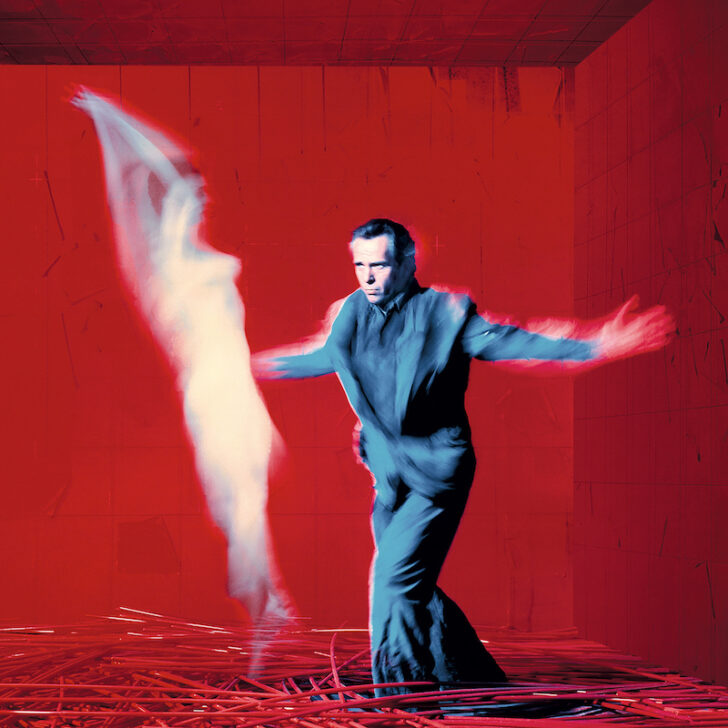
US and its visual presentation fit perfectly into this colourful world. The cover is a real production in bright red with a blue Gabriel silhouette dancing with an obviously naked woman. At least Gabriel looks tense. He can’t quite shake off the old melancholy.
Two factors were of decisive importance for US: Firstly, it appeared in the wake of the mega-success So, and for that reason alone it was sure to attract a lot of attention. Some of the songs were reminiscent of their counterparts on the previous album. On the other hand, Gabriel was at the height of his passion for world music at the time. His label Realworld had started successfully and showed many facets of music styles that were not known. And three years earlier, Passion, the soundtrack to the film Last Temptaion of Christ, had become a milestone, congenially bringing together Arabic and North African sounds with Western understanding.
So it is not surprising that US incorporated many elements of world music. There were so many, in fact, that the list of musicians involved for some songs was longer than that for an entire album in earlier times. Gabriel had included a lot that was exciting for him, and in some pieces he had put umpteen musical layers on top of each other. Some songs therefore only unfold their full power in their (by necessity) more focused live version. Secret World, for example.
It would be impossible to list all those involved. The regulars were Manu Katché, David Rhodes and Tony Levin. They were joined by Shankar, Ayub Ogada and many, many other musicians from different corners of the earth. In contrast to all the ethno elements, there were electro sound fiddlers like Brian Eno and William Orbit. The director of the whole thing was Daniel Lanois for the third (and last) time, who had to bring all the pieces together and sort them out, which he also succeeded in doing: despite the many layers, US cannot be denied a basic musical tone. It also remains accessible, even if after So, with its crowd-pleasing style, it is more of a usual Gabriel album again: It is full of emotion, full of friction, full of the courage to be non-conformist.
Remarkable is the art project that Gabriel connected with the album: For each song, a visual artist created a work that was printed in the booklet and also used for the single covers. Some of the works were very inspiring.
Contemporary reviews were favourable to enthusiastic. Rolling Stone wrote: “Most of the melodies creep in rather than shouting out their arrival from the first note. The obscure melodies and exotic rhythms reward the patient listener in the end, but not without struggle.” Entertainment Weekly, however, said, “Unfortunately, the songs themselves are terribly long and melodically boring.”
The album is very popular among the fans. Beacon songs like Digging In The Dirt or Secret World simply never lose their (live) impact. Other songs, on the other hand, could never reach their full potential: Steam, for example, or Kiss That Frog. And a few remain completely lost, such as Love To Be Loved or Only Us.
Finally, it should be noted: Sinead O’Connor’s part is generally overrated.
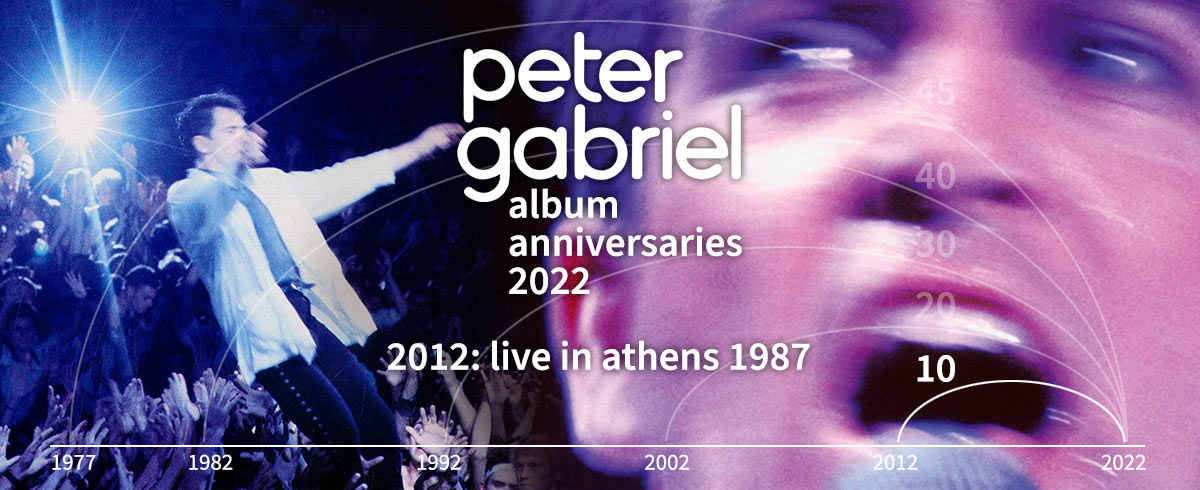
Live in Athens 1987
The conclusion of our series of articles on the album anniversaries of the 2s is a little unusual. It is somehow a re-release, but somehow not. On the other hand, the recordings come from the most brilliant and perhaps most significant phase of Gabriel’s career, which is also represented here.
So was by far his most successful album, but the tour for it was only documented with a video release three years after its completion. There was no audio album. Until 19 October 2012 – ten years ago (or 35 years after the end of the tour). That’s when the various versions of the So 25th Anniversary Edition appeared. And it included (apart from the basic version) Live In Athens 1987 on two CDs.
Ten years ago? In 2012, the London Olympics closed with a furious music party, Barack Obama was elected President of the USA for the second time and Robin Gibb died at 62.
The 25th anniversary of So was actually in 2011, but Gabriel was still on the road with the orchestra on the New Blood Tour. He celebrated the album a year later with the Anniversary Editions. And a special tour, for which he was able to get the same musicians together as on the original: Besides Levin and Rhodes, Manu Katché on drums and David Sancious on keyboards.
Many consider the 1987 So touring band to be the highest quality and most mature Gabriel has ever had. Remarkable indeed is that the individual musical personalities are not only terrific in their respective fields, they were also able to contribute and shine like hardly any PG live band after or before.
Katché’s drumming on No Self Control, Lay Your Hands On Me and In Your Eyes (to name a few) sets standards. The keyboard interludes by Sancious on Shock The Monkey and Games Without Frontiers are jazzy, playful and at the same time bring enormous drive to the pieces. And even David Rhodes is allowed to play idiosyncratic guitar solos, for example on Shock The Monkey or Don’t Give Up. Youssou N’Dour as a guest at the end is an almost legendary enrichment. And Gabriel himself is vocally and expressively at his peak.
It was really necessary that this musically exceptional performance became available as a CD. It is a pity that it happened so late – the album does not play a special role in the canon of Gabriel fans. Live In Athens 1987 is not even available separately, and is missing from most discographies (it was released separately but on vinyl in 2020).
The track list corresponds to the set list of the concerts back then – with deviations: A few tracks are missing (Red Rain, Big Time), the included Intruder was one of the rare substitute candidates on the tour and only Gabriel himself can answer why This Is The Picture was put back at the beginning, as it was on the VHS release.
Nevertheless, the recordings should be counted among the extraordinary jewels in the Gabriel cosmos, which have simply remained far too unnoticed.
Closing
This is the end of our series of articles on Gabriel’s 2nd anniversary year. The master almost managed to add another release to the round, but it looks like I/O (or whatever the album will be called) will not be released until 2023. The man is always late…
Hopefully our series of articles could provide a little mental inspiration – or evoke nostalgia. Looking back can sometimes open up new perspectives.
Don’t forget that you can continue to share your thoughts in the forum threads linked to the series.
Author: Thomas Schrage

